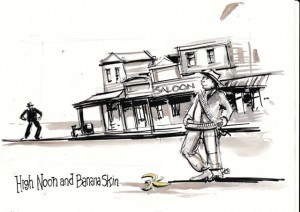Publishers note: Would you believe it! Again Quentin Cockburn (of all people) has mistaken Colt for Cult. I am at my wit’s end. Have pity.
Colts: the Gun Kind by Quentin Cockburn
 There was ‘the Colt from old regret who got away’, and then there’s my favourite the gunslingers’ Colt. The Colt that was worn by Wyatt Earp, Captain Thunderbolt, Mad Jack Morgan and the Kellys’. And lastly the Colt that’s immortalised by Clint Eastwood in those magnificent Sergio Leonie films, later enshrined as ‘The Outlaw Josie Wales’, and ‘the Unforgiven’. The inspiration is in the swagger, the loneliness of the individual, outlined, stencilled in shadow, to a ‘High Noon finale’ of stirrups jangling in unison to each (maybe their) last step.
There was ‘the Colt from old regret who got away’, and then there’s my favourite the gunslingers’ Colt. The Colt that was worn by Wyatt Earp, Captain Thunderbolt, Mad Jack Morgan and the Kellys’. And lastly the Colt that’s immortalised by Clint Eastwood in those magnificent Sergio Leonie films, later enshrined as ‘The Outlaw Josie Wales’, and ‘the Unforgiven’. The inspiration is in the swagger, the loneliness of the individual, outlined, stencilled in shadow, to a ‘High Noon finale’ of stirrups jangling in unison to each (maybe their) last step.
The Colt Revolver: A Brief description
I don’t really know much about side arms, I believe, (having checked the internet) that Mr Colt developed the revolver and Messrs Smith and Wesson perfected the metal cartridge and bullet. Colt achieved universal fame through the perfection of the first mass produced, multiple shot pistol with easily interchangeable parts, hence, you could fire more than one bullet, without having to then reload, re prime and all the rest. There’s no pause in the action, the camera can keep whirring without the pause, as the laborious process of reloading would have required, and the action, is in sync with the sequence.
To my thinking the change established the Western movie genre, because the hero, or villain, for the very first time could have multiple shots, and multiple chances. It celebrated the drama, and intensified the action. Options on the field, (and for film directors), the eternal option of the draw, the volley, and the hand action, and between it all the sequence of time changes with the revolver, the act of killing, is sped up. I suppose it’s the precursor to the machine gun, and with it Time, as depicted in the Western, is accelerated or slowed down and compressed.
I am not an expert on Westerns, having grown up on a diet of Sunday afternoon movies. I became tired of the staged routines, the slaughter of injuns and the banality of scripts deemed to be too B grade to arouse anything beyond apathy. Besides it was up against stiff competition from the surrealist gymnastics of Samurai and the Ninjas. But later, much later I became aware that the real (the genuine) Westerns were masterpieces of construction and understatement.
Now I must confess there are really only two Westerns I like, High Noon, and The Good, The Bad and The Ugly. No John Wayne, no Hopalong Cassidy, no Gunsmoke, no Rawhide and an absence of petticoats, and bonnets.
Gary Cooper is old, he looks haggard, and his young wife Grace Kelly a portrait of stoicism. The bad guys are all bad, and the landscape, in this black and white film sets the frame, each sequence. A railway track that leads into the horizon, the waiting for the train, and the nervousness of the citizens, brooding for the inevitable showdown. When the showdown does come, it is handled with an evocative restraint. The culmination of Gary Cooper’s mortality is the loading sequence, his fingers shaking as he loads the Colt revolver. The showdown is inevitable from the start, and when it happens survival is instinct, luck and practice.
The central character is a normal person.
So much of the film is carried by Gary Cooper, and this older Cooper, conscious of his mortality, and the promise of marriage and a new life, as against the certainty of death and waiting, like the two converging rail lines meeting in the distance.
The bad guys are louts, and they’re led by the evil eyed Lee Van Cleef, who reappears some decade and a half later as “Angel Eyes” in “The Good The Bad and The Ugly”.
A younger Clint Eastwood is the vehicle for good guys that aren’t all good, and bad guys that are nuanced, real bad and borderline bad. The heart of the film is about perseverance and the unlikely companionship between the opportunist and the strategist.
The final sequence, whilst no less satisfying than the showdown in High Noon, leaves the almost likable baddy hanging by his neck, as Clint rides off, with his share of the loot. He turns, aims his rifle and shoots the rope, salvation of a life, and an act of chivalry amidst a graveyard. The cross that Tuco fidgets upon is a graveyard of Civil War soldiers, nobly died. The film’s baddies prosper through their capacity to neither belong, nor live by a code of patriotism. They shackle themselves to the inevitable death as pawns in the system.
In both films the music scores are simple, repetitive and emphatic, “do not forsake me”, with the coconut percussion rhythm, and a single guitar, and The Good The Bad and The Ugly, the signature tune half crazed vocalisations, something between a hyena, and a Lunatic Asylum to reinforce the outsider as a passing shadow, unseen by the mainstream.
The message, Italian directors, and Jewish American directors, outside the mainstream, make the best commentary and allow us to see things as they really are. They employ Shakespearean comic opera with a deft touch, and a comic book simplicity to eternal truths. But I can’t actually remember any of them.
